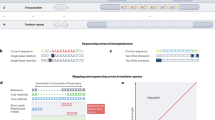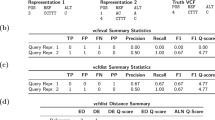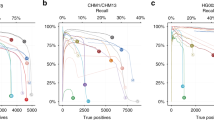Abstract
Benchmark small variant calls are required for developing, optimizing and assessing the performance of sequencing and bioinformatics methods. Here, as part of the Genome in a Bottle (GIAB) Consortium, we apply a reproducible, cloud-based pipeline to integrate multiple short- and linked-read sequencing datasets and provide benchmark calls for human genomes. We generate benchmark calls for one previously analyzed GIAB sample, as well as six genomes from the Personal Genome Project. These new genomes have broad, open consent, making this a ‘first of its kind’ resource that is available to the community for multiple downstream applications. We produce 17% more benchmark single nucleotide variations, 176% more indels and 12% larger benchmark regions than previously published GIAB benchmarks. We demonstrate that this benchmark reliably identifies errors in existing callsets and highlight challenges in interpreting performance metrics when using benchmarks that are not perfect or comprehensive. Finally, we identify strengths and weaknesses of callsets by stratifying performance according to variant type and genome context.
This is a preview of subscription content, access via your institution
Access options
Access Nature and 54 other Nature Portfolio journals
Get Nature+, our best-value online-access subscription
$29.99 / 30 days
cancel any time
Subscribe to this journal
Receive 12 print issues and online access
$209.00 per year
only $17.42 per issue
Buy this article
- Purchase on Springer Link
- Instant access to full article PDF
Prices may be subject to local taxes which are calculated during checkout


Similar content being viewed by others
Data availability
Raw sequence data were previously published in Scientific Data (https://doi.org/10.1038/sdata.2016.25) and were deposited in the NCBI SRA with the accession codes SRX1049768–SRX1049855, SRX847862–SRX848317, SRX1388368–SRX1388459, SRX1388732–SRX1388743, SRX852932–SRX852936, SRX847094, SRX848742–SRX848744, SRX326642, SRX1497273 and SRX1497276. 10x Genomics Chromium bam files used are available at ftp://ftp-trace.ncbi.nlm.nih.gov/giab/ftp/data/AshkenazimTrio/analysis/10XGenomics_ChromiumGenome_LongRanger2.0_06202016/. The benchmark vcf and bed files resulting from work in this manuscript are available in the NISTv.3.3.2 directory under each genome on the GIAB FTP release folder ftp://ftp-trace.ncbi.nlm.nih.gov/giab/ftp/release/ and, in the future, updated calls will be in the ‘recent’ directory under each genome. The data used in this manuscript and other datasets for these genomes are available at ftp://ftp-trace.ncbi.nlm.nih.gov/giab/ftp/data/, as well as in NCBI BioProject No. PRJNA200694.
Code availability
All code for analyzing genome sequencing data to generate benchmark variants and regions developed for this manuscript is available in a GitHub repository at https://github.com/jzook/genome-data-integration. Publicly available software used to generate input callsets includes novoalign v.3.02.07, samtools v.0.1.18, GATK v.3.5, Freebayes v.0.9.20, Complete Genomics tools v.2.5.0.33, Torrent Variant Caller v.4.4, LifeScope v.2.5.1, LongRanger v.2.0, GenomeWarp, rtg-tools v.3.7.1 and Sentieon v.201611.rc1.
References
Zook, J. M. et al. Integrating human sequence data sets provides a resource of benchmark SNP and indel genotype calls. Nat. Biotechnol. 32, 246–251 (2014).
Patwardhan, A. et al. Achieving high-sensitivity for clinical applications using augmented exome sequencing. Genome Med. 7, 71 (2015).
Lincoln, S. E. et al. A systematic comparison of traditional and multigene panel testing for hereditary breast and ovarian cancer genes in more than 1000 patients. J. Mol. Diagnostics 17, 533–544 (2015).
Telenti, A. et al. Deep sequencing of 10,000 human genomes. Proc. Natl Acad. Sci. USA 113, 11901–11906 (2016).
Cornish, A. & Guda, C. A comparison of variant calling pipelines using Genome in a Bottle as areference. Biomed. Res. Int. 2015, 1–11 (2015).
Poplin, R. et al. A universal SNP and small-indel variant caller using deep neural networks. Nat. Biotechnol. 36, 983 (2018).
Zook, J. M. et al. Extensive sequencing of seven human genomes to characterize benchmark reference materials. Sci. Data 3, 160025 (2016).
Eberle, M. A. et al. A reference data set of 5.4 million phased human variants validated by genetic inheritance from sequencing a three-generation 17-member pedigree. Genome Res. 27, 157–164 (2017).
Cleary, J. G. et al. Joint variant and de novo mutation identification on pedigrees from high-throughput sequencing data. J. Comput. Biol. 21, 405–419 (2014).
Krusche, P. et al. Best practices for benchmarking germline small variant calls in human genomes. Nat. Biotechnol. https://doi.org/10.1038/s41587-019-0054-x (2019).
Ball, M. P. et al. A public resource facilitating clinical use of genomes. Proc. Natl Acad. Sci. USA 109, 11920–11927 (2012).
Kudalkar, E. M. et al. Multiplexed reference materials as controls for diagnostic next-generation sequencing: a pilot investigating applications for hypertrophic cardiomyopathy. J. Mol. Diagn. 18, 882–889 (2016).
Lincoln, S. E. et al. An interlaboratory study of complex variant detection. Preprint at bioRxiv https://doi.org/10.1101/218529 (2017).
Zhou, B. et al. Extensive and deep sequencing of the Venter/HuRef genome for developing and benchmarking genome analysis tools. Sci. Data 5, 180261 (2018).
Mu, J. C. et al. Leveraging long read sequencing from a single individual to provide a comprehensive resource for benchmarking variant calling methods. Sci. Rep. 5, 14493 (2015).
English, A. C. et al. Assessing structural variation in a personal genome—towards a human reference diploid genome. BMC Genomics 16, 286 (2015).
Li, H. et al. A synthetic-diploid benchmark for accurate variant-calling evaluation. Nat. Methods 15, 595–597 (2018).
Conrad, D. F. et al. Variation in genome-wide mutation rates within and between human families. Nat. Genet. 43, 712–714 (2011).
Auton, A. et al. A global reference for human genetic variation. Nature 526, 68–74 (2015).
Beck, T. F. et al. Systematic evaluation of Sanger validation of next-generation sequencing variants. Clin. Chem. 62, 647–654 (2016).
Marks, P. et al. Resolving the full spectrum of human genome variation using linked-reads. Preprint at bioRxiv https://doi.org/10.1101/230946 (2018).
Wenger, A. M. et al. Highly-accurate long-read sequencing improves variant detection and assembly of a human genome. Preprint at bioRxiv https://doi.org/10.1101/519025 (2019).
DePristo, M. A. et al. A framework for variation discovery and genotyping using next-generation DNA sequencing data. Nat. Genet. 43, 491–498 (2011).
McKenna, A. et al. The Genome Analysis Toolkit: a MapReduce framework for analyzing next-generation DNA sequencing data. Genome Res. 20, 1297–1303 (2010).
Garrison, E. & Marth, G. Haplotype-based variant detection from short-read sequencing. Preprint at https://arxiv.org/abs/1207.3907v2 (2012).
Drmanac, R. et al. Human genome sequencing using unchained base reads on self-assembling DNA nanoarrays. Science 327, 78–81 (2010).
Kendig, K. et al. Computational performance and accuracy of Sentieon DNASeq variant calling workflow. Preprint at bioRxiv 396325 https://doi.org/10.1101/396325 (2018).
Toptaş, B. Ç., Rakocevic, G., Kómár, P. & Kural, D. Comparing complex variants in family trios. Bioinformatics https://doi.org/10.1093/bioinformatics/bty443 (2018).
Acknowledgements
We thank the many contributors to GIAM Consortium discussions. We especially thank R. Saldana and the Sentieon team for advice on running the Sentieon pipeline; A. Carroll and the DNAnexus team for advice on implementing the pipeline in DNAnexus; F. Hyland, S. Ghosh, K. Zhao and J. Bodeau at ThermoFisher for advice on integrating Ion exome and SOLiD genome data; D. Church and V. Schneider for helpful discussions about GRCh38; and many individuals for providing feedback on the current version and previous versions of our calls. Selected commercial equipment, instruments or materials are identified to specify the adequacy of experimental conditions or reported results. Such identification does not imply recommendation or endorsement by the National Institute of Standards, nor does it imply that the equipment, instruments or materials identified are necessarily the best available for the purpose. C.X. and S.S. were supported by the Intramural Research Program of the National Library of Medicine, National Institutes of Health. J.Z., M.S., N.O. and J.W. were supported by the National Institute of Standards and Technology and an interagency agreement with the Food and Drug Administration.
Author information
Authors and Affiliations
Contributions
J.M.Z., L.T., N.D.O., J.W. and M.S. wrote the manuscript. J.M.Z., J.M., F.M.D., N.D.O., J.W., M.S. and H.P. designed and implemented the integration process. H.H., J.M. and J.M.Z. analyzed and integrated the 10x Genomics data. R.T., J.M. and J.M.Z. analyzed and integrated the Complete Genomics data. S.A.I., L.T., F.M.D., J.M. and J.M.Z. designed and implemented the phasing and robust trio analysis. C.Y.M., J.M. and J.M.Z. designed and implemented the robust GRCh38 liftover analysis. C.X. and S.S. managed and analyzed data. All authors contributed to GIAB discussions planning this work.
Corresponding author
Ethics declarations
Competing interests
R.T. is an employee of, and holds stock in, Invitae. H.H. was an employee of 10x Genomics. S.A.I. and L.T. are employees of Real Time Genomics. C.Y.M. is an employee of Verily Life Sciences and Google.
Additional information
Publisher’s note: Springer Nature remains neutral with regard to jurisdictional claims in published maps and institutional affiliations.
Integrated supplementary information
Supplementary Figure 1 Fraction of each chromosome covered by benchmark regions for each genome.
Fraction of the assembled (i.e., non-N) bases in GRCh37 that are covered by the benchmark regions for each genome (HG001 to HG007), separated by chromosome.
Supplementary Figure 2 Overall flow of execution of the code used to integrate VCF and BED files from each method and form benchmark VCF and BED files.
Diagram of the input files (light orange boxes) and output files (dark orange boxes) of each script (blue boxes) used to integrate callsets from each method and form the benchmark set.
Supplementary Figure 3 Preprocessing and merging of VCF and BED files from each input callset.
The Callset Table gives metadata about each input callset, including which difficult regions to exclude from each callset’s callable bed file. This table is used to generate callable bed files for each callset and form a merged vcf that includes the genotype from each callset and annotations that indicate whether it falls in each callset’s callable bed file.
Supplementary Figure 4 Processing union VCF to arbitrate between callsets and form benchmark VCF.
Process used to determine if a consensus genotype call can be made from all trusted input callsets for each line in the union VCF. In the first iteration, each callset’s callable regions are used to determine if a callset can be trusted, and calls where all trusted callsets agree and at least two different platforms support the call are used to train the one class filtering model in Supplementary Figure 5. In the second iteration, each callset’s callable regions are again used to determine if a callset can be trusted, but filtered calls are also excluded. To be included in the benchmark set, all trusted callsets must have the same genotype, and support from only one platform is needed.
Supplementary Figure 5 One-class model used to filter calls from each input callset that have outlier annotations.
To determine whether a call from each input callset can be trusted, we use a simple one-class model that finds calls from each callset that have outlier values for any of the user-specified annotations. For the training set, we use the sites from each input callset that agree with the consensus calls supported by at least two technologies (found in the first iteration of the process in Supplementary Figure 4). The filtered bed files from each callset are used to annotate the union VCF used in the second and final iteration of Supplementary Figure 4.
Supplementary information
Supplementary Information
Supplementary Figures 1–5, Supplementary Tables 1–5 and Supplementary Notes 1–10
Supplementary Data 1
Detailed manual curation results for discordant sites
Rights and permissions
About this article
Cite this article
Zook, J.M., McDaniel, J., Olson, N.D. et al. An open resource for accurately benchmarking small variant and reference calls. Nat Biotechnol 37, 561–566 (2019). https://doi.org/10.1038/s41587-019-0074-6
Received:
Accepted:
Published:
Issue Date:
DOI: https://doi.org/10.1038/s41587-019-0074-6
This article is cited by
-
Validated WGS and WES protocols proved saliva-derived gDNA as an equivalent to blood-derived gDNA for clinical and population genomic analyses
BMC Genomics (2024)
-
Utility of long-read sequencing for All of Us
Nature Communications (2024)
-
Benchmarking long-read aligners and SV callers for structural variation detection in Oxford nanopore sequencing data
Scientific Reports (2024)
-
Reference Materials for Improving Reliability of Multiomics Profiling
Phenomics (2024)
-
A cost-effective sequencing method for genetic studies combining high-depth whole exome and low-depth whole genome
npj Genomic Medicine (2024)



